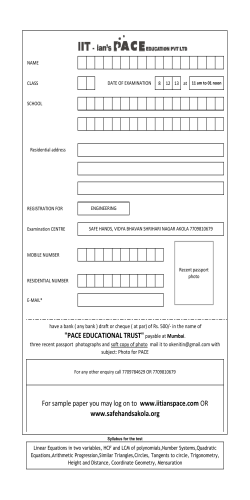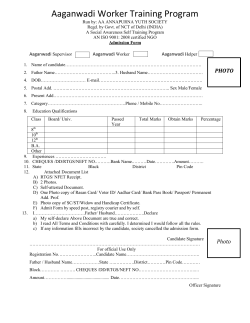
Cumulative Effects and Indigenous Law
“Enough is Enough” An Indigenous Law-Based Approach to Managing Cumulative Effects Treaty 8 Tribal Association Community Gathering March 26, 2015 Jessica Clogg, Executive Director & Senior Counsel Hannah Askew, Staff Counsel West Coast Environmental Law CUMULATIVE EFFECTS: • The combined impacts from past, present & reasonably foreseeable actions & events on the environment & human wellbeing Photo: Halalt First Nation Photo: Tumbler Ridge News WILDLIFE West Coast Environmental Law WATER West Coast Environmental Law Photo: Halalt First Nation KNOWLEDGE TRANSMISSION West Coast Environmental Law GETTING BACK ON TRACK: UNDERSTANDING THE BIG PICTURE & FOLLOWING ‘OUR WAYS’ Photo: Marie Barney Photo: Darlene Vegh AN INDIGENOUS LAW FOUNDATION FOR PLANNING & MANAGEMENT Photo: Kelly Marsden Sources of Indigenous Law Stories Can Tell Us About… • Legal processes (decisionmakers/procedural steps) • Legal obligations and rights • Legal principles about management West Coast Environmental Law Photo: Chris Thevarge Photo: Andy Wright FOLLOWING ANCESTRAL FOOTPRINTS: “OUR STORIES ARE WRITTEN ON THE LAND” Photo: Darlene Vegh EXAMPLES FROM GITANYOW LAX’YIP PROTECTION PLAN From principles to plan Gwelx ye’enst means the exercise of Gitanyow’s rights and responsibilities to hold, protect and pass on the land and water in a sustainable manner from generation to generation, including the process of developing the Gitanyow Lax’yip Land Use Plan. West Coast Environmental Law Photo: Kelly Marsden HA’NII TOKXW From principles to plan “Ha’nii tokxw” means “our food table” and is the Gitanyow designation that encompasses the land, water, air and all resources associated with Hanna Tintina and the Biodiversity Areas set out in Schedules A and B, where landscape is retained in a predominantly natural condition (as per conditions under traditional Gitanyow management) to maintain and enhance the availability of Gitanyow foods, and protect the water that is the lifeblood of the Gitanyow Lax’yip. West Coast Environmental Law Gitanyow Lax’yip Protection Plan Designations & rules for all resources values in Gitanyow territory Wilp Cultural Heritage Forest Ecosystem Networks Old Growth Management Areas Water Management Units Grizzly Habitat Moose Habitat Mountain Goat Habitat Goshawk Habitat Operable Lands Hanna Tintina Protected Area Cedar Gitanyow Huwilp Recognition & Reconciliation Model West Coast Environmental Law From principles to plan n’hlu4ik Sim’aks (Water Management Units) • Designated as roadless areas, Gitanyow Water Management Units encompass the valley walls and headwater bowls of many large rivers and streams in the territory. • Unique forests, with high conservation values for water quality and watershed hydrology. West Coast Environmental Law From principles to plan En’sii’wineex (Hydroriparian Ecosystem Networks) • Full hydroparian zone plus one and one-half tree heights distance reserved for streams in network. • Protects hydroriparian ecosystems; biodiversity ‘hotspots’, high habitat values, important wildlife movement corridors and Gitanyow cultural features; facilitates migration of plant and animal species and gene pools through the landscape; & connect habitats across all elevations. West Coast Environmental Law Photo: Noba Anderson Indigenous law foundation for planning and management: building blocks • Indigenous law principles • Description of historic “base case” • Mapping and recording of traditional use information & knowledge Photo: Andy Wright Photo: Brian Huntington ESTABLISHING STRATEGIC LEVEL DIRECTION: FOOD AND WATER SECURITY PLANNING ? Photo: BC Hydro EVALUATE CUMULATIVE EFFECTS OF DIFFERENT DEVELOPMENT SCENARIOS Taku River IPP; Photos: Ecotrust Canada What plausible future scenarios have the greatest mutually reinforcing positive ecological, social and economic benefits, while upholding the title and rights of individual nations? West Coast Environmental Law GOVERNMENT-TO-GOVERNMENT NEGOTIATIONS/DECISION-MAKING West Coast Environmental Law 22 Photo: Kelly Marsden Government -toGovernment Arrangements • Strategic land use agreements • Co-management of assessment, approvals and monitoring • Benefit sharing Thank you! Facebook: www.facebook.com/WCELaw Twitter: @WCELaw Web: www.wcel.org West Coast Environmental Law Elements of Cumulative Effects Management: • Establish strategic level direction • Assess, manage and regulate activities to ensure objectives are met • Monitor effects & undertake adaptive management Photo: Wayne Sawchuk Photo: Photo: Andy Andy Wright Wright Managing Cumulative Effects in BC: Law Reform Solutions • 2 year WCEL research project • Includes analyzing institutional models with potential for use in the cumulative effects context from BC, North America and internationally. • 40 ‘models’ examined to date • Looking for examples of innovation and best practices – what is or is not working West Coast Environmental Law Institutional Mechanisms: Framework for Analysis • How is collaboration among and within governments (including First Nations governments) and with non-governmental actors structured? • Nature and scope of authority/activities? • How is scientific and Indigenous knowledge used in decision-making? • How are outcomes integrated into land and resource decision-making? • How is the model funded? West Coast Environmental Law
© Copyright 2025









